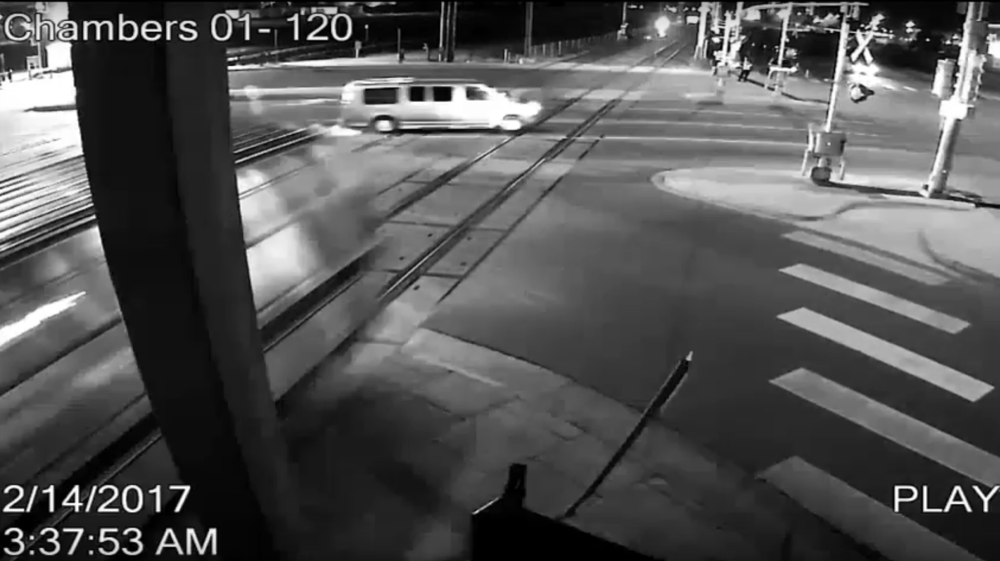
Updated 7:30 p.m. to reflect new footage.
The Aurora Police Department has released surveillance footage of the high-speed crash that left the driver of a passenger van dead and several A Line passengers with minor injuries on Feb. 14.
The video, captured by trackside cameras, shows that the van stopped between sets of rails and waited for nearly two minutes before the collision. The gates around the crossing appear to have closed as intended before the train arrived, leaving an exit gate open as part of a safety system designed to allow trapped vehicles to exit the intersection.
The footage shows the vehicle began to move just before the train arrived and was struck as it drove across the rails. Aurora police are investigating whether the van driver, identified as Billy Ray Guinn, 57, may have intended to cause the crash.
In detail:
The collision happened at the Chambers Road crossing, where two separate sets of rails cross the road. As the footage shows, the conversion van drove into the intersection area and stopped in a wide stretch of road between the two rails.
The van then idled for some time in the roughly 60-foot stretch of road between the two sets of train tracks. The entrance gates closed behind the vehicle, but video footage shows that exit gates remained open in front of the van, on the far side of the second set of tracks
The exit gates remained open intentionally during this time as part of a safety system, according to RTD. Sensors at the crossing can detect the presence of a vehicle and leave the exit gates open as an escape route, RTD spokesman Nate Currey said.
"It worked exactly as it was supposed to," Currey said. Robert Halstead, a railroad accident reconstruction expert, confirmed that this is standard design for "quad" crossings.
After about 38 seconds, the van started moving forward toward the open gate, according to video footage. The van was in motion and crossing the tracks when it was T-boned by the passenger train at high speed.
Currey said the intersection included multiple safety measures designed to warn automobile drivers of impending danger.
"Those lights are flashing, they’ve got the bells going off like crazy. We had a flagger and Aurora police officer waving at him saying, 'Get out get out, get out, get out,' " Currey said. "There was every opportunity provided, including human contact, for him to get out of that intersection."
The intersection has gates only on the outside of the two sets of tracks. There were no internal gates that could have directly prevented the driver from proceeding from the paved middle of the intersection onto the tracks. That also is common, Halstead said.
Aurora police also have said an off-duty officer assigned to the intersection attempted to stop the van or get it out of the crossing area, although the video footage does not appear to show any person near the van just before the collision. The Aurora Police Department has posted surveillance footage of the crash online.
Aurora police are investigating whether the driver's act was intentional.
Halstead, the accident expert, said that in most suicide cases the automobile drivers actually stop directly on the train tracks, as it's extremely difficult to time the kind of collision that happened in Aurora on Tuesday.
"That may not always be a suicide," he said. "One of the things at play here is that trains are big, and it’s very difficult for motorists to accurately estimate their speed and therefore the instant at which they’ll arrive at the intersection. People horribly misjudge."
Anyone with information about this case is asked to call Agent Steve Chinn with the Aurora police's traffic investigation unit at 303-739-6342.
Update:
Here's how RTD described the functioning of the gates, according to the Denver Post. It reinforces the sequence of events and interpretation above.
“There are other angles that show the crossing’s EXIT gates, that also activated properly, by remaining open (to allow a vehicle that is inside the entrance gates to escape the intersection prior to the arrival of the train) and then the exit gates properly close.
“There is also a traffic signal near the EXIT gates that properly remains green after the ENTRANCE gates close, which lets the vehicle driver know they should get out of the intersection while the EXIT gates remain up.”












